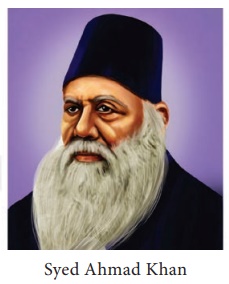Towards Modernity - Islamic Reform Movements | 11th History : Chapter 19 : Towards Modernity
Chapter: 11th History : Chapter 19 : Towards Modernity
Islamic Reform Movements
Islamic Reform Movements
The Revolt of 1857 and its brutal suppression by
the British had an adverse impact on the Muslims of South Asia. While they were
viewed with suspicion by the British for the 1857 insurgency, the Muslims
themselves withdrew into a shell and did not use the opportunities opened up by
colonial modernity. Consequently, they lagged behind in education and attendant
employment opportunities. In this context, a few decades later some reform
movements emerged among the Muslims.
Aligarh Movement (1875)

Aligarh Movement was started by Syed Ahmad Khan in
1875. He wanted to reconcile Western scientific education with the teachings of
the Quran. The Aligarh movement aimed at spreading (i) Modern education among
Indian Muslims without weakening their allegiance to Islam, and (ii) Social
reforms among Muslims relating to purdah, polygamy, and divorce.
Syed’s progressive social ideas were propagated
through his magazine Tahdhib-ul-Akhluq (Improvement
of Manners and Morals). Syed Ahmad
Khan’s educational programme emphasized from the outset the advantages of the
use of English as the medium of instruction. In 1864 he founded a Scientific
Society of Aligarh for the introduction of Western sciences through
translations into Urdu of works on physical sciences. The same year he founded
a modern school at Ghazipur. In 1868 he promoted the formation of education
committees in several districts, to initiate modern education among the
Muslims.
During his visit to Europe in 1869–70 he developed
the plans of his life -work, a major educational institution for Indian
Muslims. In order to promote English education among the Muslims, he founded in
1875 a modern school at Aligarh, which soon developed into the Muhammdan
Anglo–Oriental College (1877). This college was to become the Muslim University
after his death. It became the nursery of Muslim political and intellectual
leaders.
In 1886 Syed Ahmad Khan founded the Muhammedan
Anglo Oriental Educational Conference as a general forum for spreading liberal
ideas among the Indian Muslims. He rejected blind adherence to religious law
and asked for a reinterpretation of the Quran in the light of reason to suit
the new trends of the time. He attempted to liberalize Indian Islam and made it
amenable to new ideas and new interpretations. In this mission he had to face
the brunt of vehement attacks of orthodox theologians.
Ahmadiya Movement (1889)
The Ahmadiya movement founded by Mirza Ghulam Ahmed
(1835–1908) in 1889 established a different trend. While emphasizing the return
to the original principles enunciated in the Quran, Ghulam Ahmed became
controversial when he claimed to be a Messiah, which was considered heretical by
mainstream Islam. But he won many converts. His primary work was to defend
Islam against the polemics of the Arya Samaj and the Christian missionaries. In
social morals the Ahmadiya movement was conservative, adhering to polygamy,
veiling of women, and the classical rules of divorce.
The Deoband Movement (1866)
The Deoband movement was organised by the orthodox
section among the Muslim ulemas as a revivalist movement with the twin
objective of propagating the pure teachings of the Quran and Hadis among Muslims.
The movement was established in Deoband in Saranpur district (by Mohammad Qasim
Nanotavi (1833-1877) and Rashid Ahmed Gangohi (1828–1905) to train religious
leaders for the Muslim community. In contrast to the Aligarh Movement, which
aimed at the welfare of Muslims through Western education and support of the
British Government, the aim of the Deoband Movement was religious regeneration
of the Muslim community. The instruction imparted at Deoband adhered to
classical Islamic tradition.
The seminary at Deoband was founded in 1867 by
theologians of the School of Wali-Allah. Muhammad Qasim Nanotavi took a
prominent part in counter-polemics against the Christian missionaries and the
Arya Samajists. The principal objectives of the seminary at Deoband were to
re-establish contact between the theologians and the educated Muslim middle
classes, and to revive the study of Muslim religious and scholastic sciences.
As a religious university Deoband soon became an honoured institution, not only
in Muslim India but also in the world of Islam at large.
Nadwat al-‘ulama
A school less conservative than Deoband and more
responsive to the demands of the modern age was the Nadwat al-‘ulama,’ founded
in 1894 at Lucknow by the historian Shibli Nu‘mani and other scholars. The
school aimed to offer an enlightened interpretation of religion in order to
fight the trends of agnosticism and atheism which had followed the advent of
modern Western education.
Farangi Mahal
The third famous traditional school is the much
older one at Farangi Mahal in Lucknow. Farangi Mahal accepted Sufism as a valid
experience and a valid field of study. Another traditionalist movement was the ahl-i-hadith or of the followers of the
dicta of the Prophet.
Related Topics